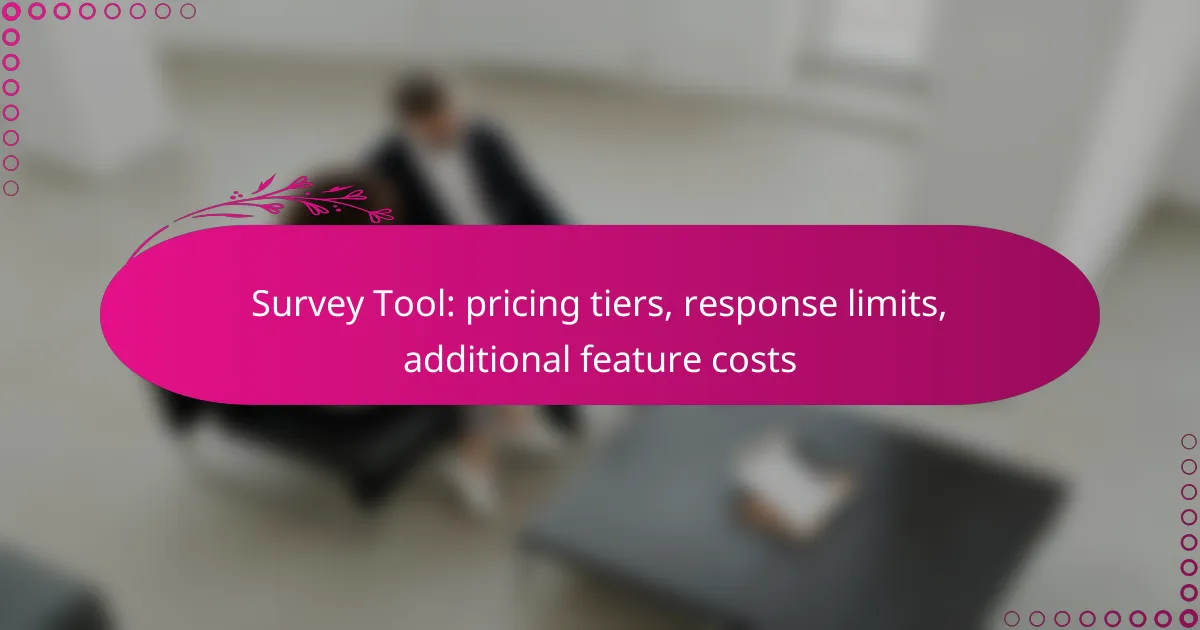Survey tools in Canada typically offer three main pricing tiers: Basic, Pro, and Enterprise, each designed to meet different user needs and budgets. It’s essential to understand the response limits associated with each tier, especially if you expect a high volume of responses. Additionally, consider the costs of any additional features that may enhance your survey experience, as these can vary widely among providers.

What are the pricing tiers for survey tools in Canada?
Survey tools in Canada typically offer three main pricing tiers: Basic, Pro, and Enterprise. Each tier provides varying features and response limits, catering to different user needs and budgets.
Basic tier pricing
The Basic tier usually ranges from CAD 20 to CAD 50 per month. This tier often includes essential features such as unlimited surveys, basic question types, and a limited number of responses, typically around 100 to 500 per survey.
When selecting a Basic tier, consider the size of your audience and the complexity of your surveys. If your needs are straightforward and you have a smaller respondent pool, this tier may suffice.
Pro tier pricing
The Pro tier generally costs between CAD 50 and CAD 150 per month. This level often includes advanced features like custom branding, enhanced analytics, and increased response limits, often allowing up to 2,000 responses per survey.
Choosing the Pro tier is beneficial for businesses that require more sophisticated data analysis and a larger participant base. Ensure that the additional features align with your survey goals to maximize value.
Enterprise tier pricing
Enterprise tier pricing varies widely, typically starting around CAD 150 and going up to several hundred dollars per month, depending on the provider and specific requirements. This tier is designed for large organizations and includes features like dedicated support, custom integrations, and unlimited responses.
When considering the Enterprise tier, evaluate your organization’s survey volume and the need for tailored solutions. This option is ideal for companies that conduct extensive research and require robust data management capabilities.

What are the response limits for popular survey tools?
Response limits for popular survey tools vary significantly based on the pricing tier and features selected. Understanding these limits is crucial for choosing the right tool for your survey needs, especially if you anticipate a high volume of responses.
SurveyMonkey response limits
SurveyMonkey offers different response limits depending on the subscription plan. Free users can collect up to 100 responses per survey, while paid plans allow for higher limits, often reaching thousands of responses. For example, the Team plan can support unlimited responses, making it suitable for larger organizations.
When using SurveyMonkey, consider that exceeding the response limit may require upgrading your plan or starting a new survey. Always check your current plan details to avoid interruptions.
Typeform response limits
Typeform’s response limits also depend on the selected pricing tier. Free accounts typically allow up to 100 responses per month, while paid plans can accommodate thousands. The Pro plan, for instance, provides unlimited responses, which is ideal for extensive data collection.
It’s important to monitor your response count if you’re on a limited plan, as reaching the cap will prevent further submissions until the next billing cycle. Typeform’s user-friendly interface makes it easy to track your response metrics.
Google Forms response limits
Google Forms does not impose strict response limits like other survey tools. Users can collect an unlimited number of responses, making it a popular choice for those needing extensive data collection without additional costs. However, Google does have a total storage limit for responses, which is typically around 2 million cells in a spreadsheet.
While Google Forms is free and offers unlimited responses, be mindful of the data organization in Google Sheets, as large datasets can become unwieldy. Regularly reviewing and cleaning up your data can help maintain efficiency.

What additional feature costs should I consider?
When evaluating survey tools, it’s crucial to consider the costs associated with additional features that can enhance functionality. These costs can vary significantly based on the provider and the specific features you need, such as advanced analytics, custom branding, and integration with other tools.
Advanced analytics costs
Advanced analytics features typically come at an extra cost, often ranging from a few dollars to several hundred per month, depending on the complexity and depth of the analytics provided. These features may include detailed reporting, predictive analytics, and data visualization tools that help you interpret survey results more effectively.
When considering advanced analytics, assess your needs carefully. If basic reporting suffices, you may avoid these costs. However, if you require in-depth insights, investing in these features can provide significant value.
Custom branding costs
Custom branding options allow you to personalize surveys with your logo, colors, and fonts, enhancing your brand’s visibility. Many survey tools charge a premium for these features, typically ranging from $10 to $50 per month, depending on the level of customization offered.
Before opting for custom branding, evaluate how important brand consistency is for your surveys. If you frequently distribute surveys to clients or stakeholders, investing in custom branding can improve recognition and trust.
Integration costs with other tools
Integrating survey tools with other software, such as CRM systems or email marketing platforms, often incurs additional fees. These costs can vary widely, from free integrations to monthly fees of $20 or more, depending on the complexity of the integration and the tools involved.
Consider your existing tech stack and the necessity of seamless data transfer between platforms. If integration can streamline your workflow, the investment may be worthwhile, but be cautious of hidden costs associated with ongoing maintenance or additional features.

How do I choose the right survey tool for my needs?
Choosing the right survey tool involves assessing your specific requirements, including pricing, response limits, and additional features. Consider what you need in terms of functionality and budget to find a tool that aligns with your goals.
Criteria for selection
When selecting a survey tool, focus on key criteria such as pricing tiers, user interface, and response limits. Determine your budget and the number of responses you expect to gather, as many tools offer tiered pricing based on these factors.
Additionally, consider the ease of use for both you and your respondents. A user-friendly interface can significantly enhance response rates and data quality. Look for tools that offer customization options to match your branding and survey goals.
Comparison of features
Survey tools vary widely in features, including question types, analytics capabilities, and integrations with other software. Basic plans often include standard question formats, while premium tiers may offer advanced logic, branching, and multimedia options.
Response limits are another critical feature to compare. Some tools may allow unlimited responses at higher pricing tiers, while others impose strict limits. Evaluate what additional features, such as real-time reporting or mobile compatibility, are included in each pricing tier to ensure you get the best value for your needs.

What are the common integrations for survey tools?
Survey tools often integrate with various platforms to enhance functionality and streamline data collection. Common integrations include customer relationship management (CRM) systems and email marketing platforms, which help automate processes and improve response rates.
CRM integrations
Integrating survey tools with CRM systems allows businesses to collect and analyze customer feedback directly within their existing customer databases. This integration facilitates better customer insights and helps tailor marketing strategies based on survey responses.
Popular CRM platforms like Salesforce, HubSpot, and Zoho offer seamless integration options. When choosing a survey tool, consider how well it connects with your CRM to ensure smooth data flow and avoid manual entry errors.
Email marketing integrations
Email marketing integrations enable survey tools to automatically send surveys to targeted email lists, increasing response rates and engagement. This integration allows for personalized survey invitations based on user behavior or demographics.
Tools like Mailchimp, Constant Contact, and SendinBlue commonly integrate with survey platforms. When selecting a survey tool, check for features like automated follow-ups and response tracking to maximize the effectiveness of your email campaigns.

What are the emerging trends in survey tools?
Emerging trends in survey tools focus on enhancing user experience and leveraging technology for better data analysis. Key developments include the integration of AI-driven insights, mobile optimization, and advanced customization options.
AI-driven insights
AI-driven insights in survey tools utilize machine learning algorithms to analyze responses and identify patterns. This technology helps organizations gain deeper understanding from their data, often revealing trends that may not be immediately apparent through traditional analysis.
When selecting a survey tool with AI capabilities, consider the types of insights offered, such as sentiment analysis or predictive analytics. These features can significantly enhance decision-making processes by providing actionable recommendations based on survey results.
However, be cautious of over-relying on AI insights without human oversight. It’s essential to validate AI findings with qualitative data to ensure accuracy and relevance. Aim for a balance between automated analysis and expert interpretation to maximize the effectiveness of your survey results.
